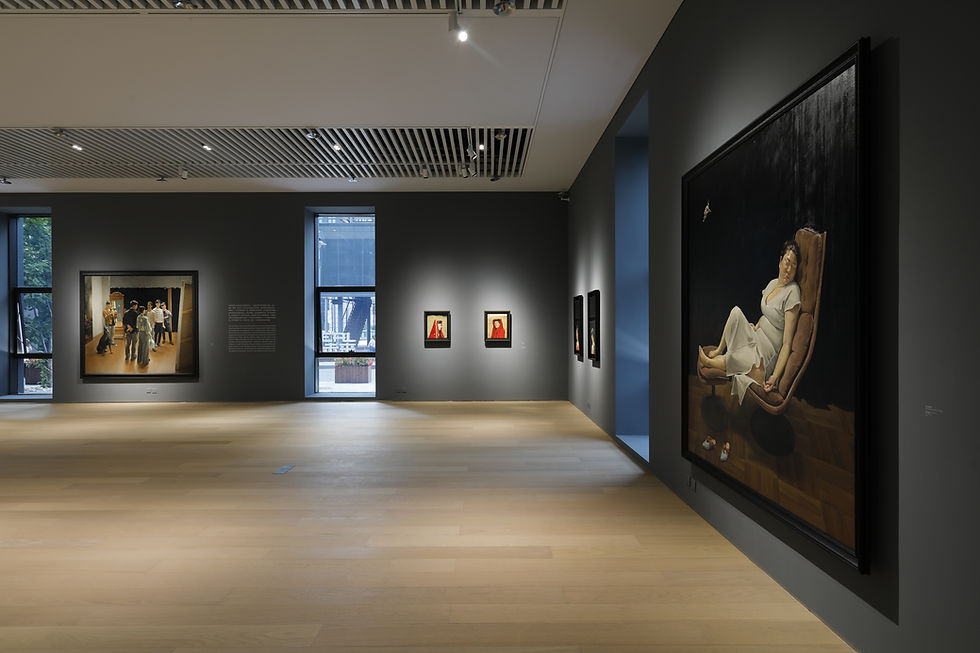Tang Contemporary Art is proud to announce the opening of artist You Yong's solo exhibition on Aug. 27th, 4PM at Beijing Headquarters Gallery Space. The exhibition will present around 70 pieces of selected works, with a focus on the artist's figure, landscape and still-life paintings.
Acquisition and Creation - About You Yong’s Paintings
Author: Wang Min’an
It seems a little out of place that a young painter who has been immersed in the long tradition of European painting decides to distance himself from various contemporary painting trends; but in another sense, it also requires courage, or, in other words, self-confidence to do that. Contrary to popular belief of many young artists, You Yong believes that the tradition of painting including classical realism and modernism since Cézanne and Vincent van Gogh is still alive (for many young people, modernism is also a dead tradition). In other words, he really loves and is familiar with this long tradition that is both coherent and heterogeneous. He can feel the magic of this tradition across time and space so he seems reluctant to give up any of its styles completely. He dived into this great and broad tradition and repeatedly trained and learned in different styles of this tradition. That’s why he often oscillates between the calm classical realism and the ardent modernism represented by Vincent van Gogh. He goes to museums to copy the original masterpieces and also paints freely and passionately by himself. Of course, we can say that You Yong’s Personal style has not been finalized (he is still young), he is still exploring. But we can also say that it is this kind of exploration with special training and acquisition that constitutes his unique style. We might even say that he expresses his immediate feelings through his unique training and acquisition. Training and acquisition can be a way of creating besides a way of learning. People always set training apart from creation, as if creation is only possible after sufficient training. However, what makes You Yong’s practice meaningful is that he creates something during repeated training and acquisition. His training and acquisition do not serve as a process leading to maturity. Instead, they are mature creations by themselves. In this sense, we can also say that his oscillation between classicism and modernism doesn’t mean that his style hasn’t been finalized yet. The oscillation is his style.
His style is formed by combining the acquisition through training with the occasional scene at hand, just like combining the learning of Diego Velázquez’s style with a subject of Chen Danqing’s figure painting. It’s like transforming Vincent van Gogh’s The Potato Eaters into Young Men Playing Mahjong. It was an obvious learning process, but also his own creative process. In fact, this is an appropriate combination of acquisition and creation. I would say it’s a particular style of creation, as well as a unique way of dealing with classics: people have their own ways of dealing with classic works. Las Meninas has a long tradition of being processed and repainted (both Picasso and Dali treated it very aggressively), yet You Yong still sees it as a great classic and roots his creation in learning such a classic. The peculiarity of this approach is that it exposes and obscures both acquisition and creation simultaneously: on one side, there are distinct elements of training and acquisition in the painting—those portraits are like training works or sketching exercises. But on the other side, the subjects of the portraits look so natural, vivid, and alive even with their solemn looks. He brings the subjects to life intuitively, without a trace of technique. It seems like the painstaking training has vanished into thin air, even if the brushstrokes are so striking. In other words, You Yong’s works of this kind can magically evoke a special experience: you can see the training of skills in these works; but when you look into the face of the subject, you would forget about all skills involved. In fact, we see a wide variety of portraits today, many of which repeatedly erase elements of training—they are reckless, daringly deformed or abstractive; on the contrary, many others only show the essential techniques of training instead of the gaze, the soul, or the inwardness of a human. The significance of You Yong’s practice is that he retains the seemingly incompatible aspects at the same time. His work shows that academic training is not incompatible with contemporary life. A trained technique does not necessarily lead to empty stylization as one might imagine. Instead, the subjects of You Yong’s portraits are often full of hidden passions even though they may look silent, stern, dignified, reticent, or preoccupied. They have very distinct identities and personalities, but their common feature is unhappiness. In You Yong’s paintings, it seems that all the people are neither happy nor relaxed. Not only the subjects of his individual portraits but also the subjects of his double portraits and group portraits are sullen and perturbed, even if they are living together or resting together. I would like to point out that while painting the figures and backgrounds, You Yong always emphasized special painting grammar and techniques, such as the contrast of light and shadow, the partial deletion of space, and the prominent brushstrokes on small paintings. This is part of what You Yong has learned from tradition.
I don’t know if the unhappiness shown in his portrait is a common feeling for You Yong. The anxiety displayed in his thirty-year-old self-portrait is impressive. In his large painting Marine Creatures, which is a painting about fish, there are a large number of emotionless fish, although Zhuang Zhou asserted that fish must be happy. Fish was a common subject in traditional European painting. Abraham van Beijeren, Diego Velázquez, Jean-Baptiste-Siméon Chardin, Gustave Courbet all have classic works depicting fish taken out of water. However, You Yong’s painting is more than that, it is also a record of how to draw a fish. This is a painting competition between fish, a painting competition between dinner plates, or a painting competition between You Yong’s works. In this huge painting that is ten meters long, he presented different fishes on different plates, demonstrating unique spatial relationships between different fishes and plates. The soft and flexible shape of the fish is shaped by the plate. The shape of the fish, or you could say, its way of being is transformed by the plate. Each fish in this painting is an individual small painting, laid out and juxtaposed laterally, contrasting with each other. As if the painter found every small painting so unsatisfactory that he had to draw another one with a similar subject. Or the painter was so pleased with every piece that he couldn’t resist drawing another one. It is differentiated repetition as well as repetitive difference. This differential repetition decentralizes the layout of the picture so that none of the fish is dominant or subordinate. This is a game of the differences between fish, also a game of painting techniques. Through the game of differential repetition, painting turns back to itself. And the meaning of a fish also lies in its contrast with other fish and the difference that is shown. They are like mirror images of each other, and reflections of mutual differences: a fish is unique because it is different from other fish and painted differently. Each fish has its own specificity and relies on its specificity to survive. Although they are all dead, they all seem alive magically. Each one of them shows its own life through its death, specificity, and difference from other fish. But this is not an attempt to explore the philosophical question of life and death through painting, but to explore painting with the philosophical question of life and death. Painting is above philosophy. It can also be said that the issue of painting, painting techniques and styles weighs like the issue of life and death to an artist—in this sense, painting is above philosophy.
 Tibetan CourtyardOil on board 53 × 65 cm 2015 | 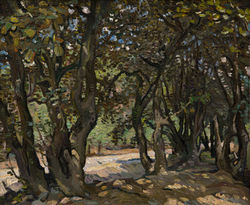 Tree Silhouette in NyingchiOil on board 50.5 × 60.5 cm 2015 |  The Dream of Yang TianzhenOil on canvas 220 × 200 cm 2022 |
|---|---|---|
 Summer at Liangma RiveriPad drawing, archival prints 66 × 90 cm 2022 |  Tajik Father and SonOil on canvas 46 × 55 cm 2021 |  Snake Wine, Taro, Winter Bamboo Shoots in FenghuaOil on board 50 × 60 cm 2021 |
 Sally in Red HeadclothOil on canvas 55 × 46 cm 2021 | 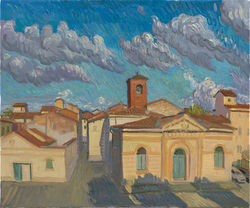 Sailing Clouds - LuccaOil on canvas 50 × 60 cm 2019 |  Petersburg-Street ViewOil on canvas 50 × 60 cm 2018 |
 Red from the PlateauOil on board 50 × 40 cm 2021 |  Profile Self-Portrait of Aged ThirtyOil on board 42 × 30 cm 2018 |  Pamir Red(Tax officer)Oil on board 50 × 40 cm 2021 |
 Ornamental Stone and EggsOil on board 30 × 40 cm 2022 | 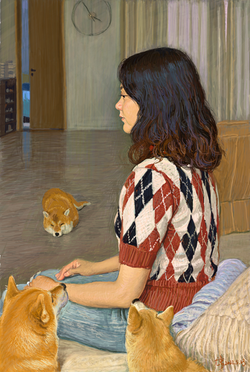 Neighbor at Aranya 86iPad drawing, archival prints 90 × 60 cm 2022 |  Old Woman in White HeadscarfOil on canvas 55 × 46 cm 2021 |
 Golden MountainOil on canvas 46 × 55 cm 2021 |  Fable of the Words and TruthOil on board 65 × 91 cm 2020 | 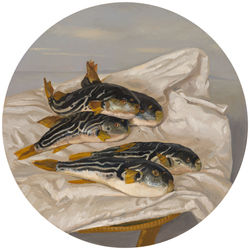 Globefish No.2Oil on board Diameter 61 cm 2016 |
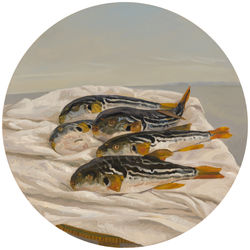 Globefish No.1Oil on board Diameter 61 cm 2016 | Curtain VariationOil on board 38 × 318 cm(7Banner) 2016 | 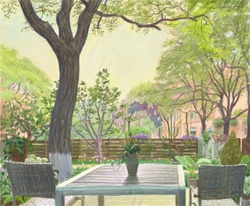 Before SandstormiPad drawing, archival prints 75 × 90 cm 2022 |
 Allegory of PaintingOil on canvas 200 × 220 cm 2021 |  Aquatic BirdsOil on board 40 × 50 cm 2019 | 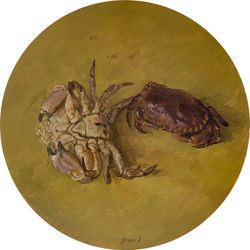 Bread CrabOil on board Diameter 61 cm 2016 |
Artist

You Yong
Born on September 25, 1988 in Wenzhou City, Zhejiang Province. You Yong has a complete academy education system, from the High School Affiliated to CAFA, Central Academy of Fine Arts, to a Ph.D. student under Yang Feiyun in the Chinese National Academy of Arts.
His painting style is built upon not only his solid practice basement but also his unique and sensitive painting sensation. His works contain the classical spirit and present vividity, also perfectly mix the animated, introverted brushstroke color and tender, elegant temperamental character. Confronting the stunning choices of painting that the boundaries in the contemporary have been limitlessly broadened, You Yong appears his remarkable critical thinking, independent appreciation, inner courage, concentration on accumulation, and tendency towards eclectic; he has traveled an exclusive road of painting in the practice of constant reflection and introspection.
You Yong's recent exhibitions include:“You Yong's Solo Exhibition”(Tang Contemporary Art, Beijing, 2022);“Academic Invitational Exhibition of the Oil Painting School of Chinese National Academy of Arts”(Zhejiang Exhibition Hall,Hangzhou, 2021);“Educational Achievement Exhibition of China National Academy of Arts”(National Museum of China, Beijing, 2019);“East Meets West: Italian and French Sketch Works Exhibition by Chinese Academy of Oil Painting”(Oil Painting School of Chinese National Academy of Arts,Beijing, 2019);“Solo Exhibition: Learning and Constantly Practicing”(Oil Painting School of Chinese National Academy of Arts, Beijing, 2019);“Beyond Language: Realistic Painting in China”(MEAM European Museum of Modern Art, Barcelona, Spain, 2019)et cetera. His works have also been exhibited in National Art Museum of China, Museum of Tsinghua University, Jiangxi Provincial Art Museum, Lingnan Museum of Fine Art, Zhangzhou Art Museum (New), Inner Mongolia Art Museum, Baotou Art Museum, Ordos Asian Art Festival et cetera


